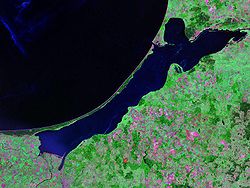Haff disease

Editor-In-Chief: Prab R Tumpati, MD
Obesity, Sleep & Internal medicine
Founder, WikiMD Wellnesspedia &
W8MD medical weight loss NYC and sleep center NYC
| Haff disease | |
|---|---|

| |
| Synonyms | N/A |
| Pronounce | N/A |
| Specialty | N/A |
| Symptoms | Rhabdomyolysis, muscle pain, weakness, brown urine |
| Complications | N/A |
| Onset | 24 hours after consuming affected fish |
| Duration | Variable |
| Types | N/A |
| Causes | Consumption of certain types of fish |
| Risks | Eating fish from affected areas |
| Diagnosis | Clinical evaluation, creatine kinase levels |
| Differential diagnosis | Myositis, polymyositis, trichinosis |
| Prevention | N/A |
| Treatment | Supportive care, hydration, dialysis if necessary |
| Medication | N/A |
| Prognosis | Generally good with treatment |
| Frequency | Rare |
| Deaths | Rare |
Haff disease is a rare syndrome of unexplained rhabdomyolysis following consumption of certain types of fish; it is caused by an unidentified toxin in the fish.
Symptoms[edit]
The primary symptom of Haff disease is rhabdomyolysis, a condition in which skeletal muscle breaks down rapidly. Symptoms can be mild or severe and may include muscle stiffness, pain, and dark urine. Other symptoms may include nausea, vomiting, chest pain, and shortness of breath.
Causes[edit]
The exact cause of Haff disease is unknown, but it is believed to be caused by a toxin in certain types of fish. The disease has been associated with the consumption of buffalo fish, freshwater pompano, and several other species of fish.
Diagnosis[edit]
Diagnosis of Haff disease is based on the presence of rhabdomyolysis following the consumption of fish. Laboratory tests may show high levels of creatine kinase and myoglobin in the blood and urine.
Treatment[edit]
Treatment for Haff disease is primarily supportive and includes hydration to help flush the myoglobin out of the kidneys. In severe cases, hospitalization may be required.
Prevention[edit]
Prevention of Haff disease involves avoiding the consumption of fish species associated with the disease.
See also[edit]
Ad. Transform your life with W8MD's Budget GLP-1 injections from $75


W8MD offers a medical weight loss program to lose weight in Philadelphia. Our physician-supervised medical weight loss provides:
- Weight loss injections in NYC (generic and brand names):
- Zepbound / Mounjaro, Wegovy / Ozempic, Saxenda
- Most insurances accepted or discounted self-pay rates. We will obtain insurance prior authorizations if needed.
- Generic GLP1 weight loss injections from $75 for the starting dose.
- Also offer prescription weight loss medications including Phentermine, Qsymia, Diethylpropion, Contrave etc.
NYC weight loss doctor appointmentsNYC weight loss doctor appointments
Start your NYC weight loss journey today at our NYC medical weight loss and Philadelphia medical weight loss clinics.
- Call 718-946-5500 to lose weight in NYC or for medical weight loss in Philadelphia 215-676-2334.
- Tags:NYC medical weight loss, Philadelphia lose weight Zepbound NYC, Budget GLP1 weight loss injections, Wegovy Philadelphia, Wegovy NYC, Philadelphia medical weight loss, Brookly weight loss and Wegovy NYC
|
WikiMD's Wellness Encyclopedia |
| Let Food Be Thy Medicine Medicine Thy Food - Hippocrates |
Medical Disclaimer: WikiMD is not a substitute for professional medical advice. The information on WikiMD is provided as an information resource only, may be incorrect, outdated or misleading, and is not to be used or relied on for any diagnostic or treatment purposes. Please consult your health care provider before making any healthcare decisions or for guidance about a specific medical condition. WikiMD expressly disclaims responsibility, and shall have no liability, for any damages, loss, injury, or liability whatsoever suffered as a result of your reliance on the information contained in this site. By visiting this site you agree to the foregoing terms and conditions, which may from time to time be changed or supplemented by WikiMD. If you do not agree to the foregoing terms and conditions, you should not enter or use this site. See full disclaimer.
Credits:Most images are courtesy of Wikimedia commons, and templates, categories Wikipedia, licensed under CC BY SA or similar.
Translate this page: - East Asian
中文,
日本,
한국어,
South Asian
हिन्दी,
தமிழ்,
తెలుగు,
Urdu,
ಕನ್ನಡ,
Southeast Asian
Indonesian,
Vietnamese,
Thai,
မြန်မာဘာသာ,
বাংলা
European
español,
Deutsch,
français,
Greek,
português do Brasil,
polski,
română,
русский,
Nederlands,
norsk,
svenska,
suomi,
Italian
Middle Eastern & African
عربى,
Turkish,
Persian,
Hebrew,
Afrikaans,
isiZulu,
Kiswahili,
Other
Bulgarian,
Hungarian,
Czech,
Swedish,
മലയാളം,
मराठी,
ਪੰਜਾਬੀ,
ગુજરાતી,
Portuguese,
Ukrainian


